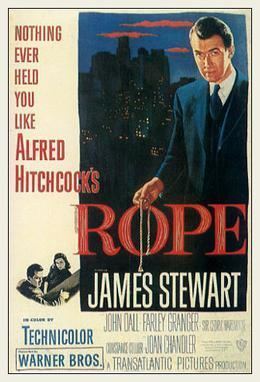 | ||
In filmmaking, a long take is a shot lasting much longer than the conventional editing pace either of the film itself or of films in general. Significant camera movement and elaborate blocking are often elements in long takes, but not necessarily so. The term "long take" should not be confused with the term "long shot", which refers to the distance between the camera and its subject and not to the temporal length of the shot itself. The length of a long take was originally limited to how much film a motion picture camera could hold, but the advent of digital video has considerably lengthened the maximum potential length of a take.
Contents
Examples of long takes
When filming Rope (1948), Alfred Hitchcock intended for the film to have the effect of one long continuous take, but the cameras available could hold no more than 1000 feet of 35 mm film. As a result, each take used up to a whole roll of film and lasts up to 10 minutes. Many takes end with a dolly shot to a featureless surface (such as the back of a character's jacket), with the following take beginning at the same point by zooming out. The entire film consists of only 11 shots.
Andy Warhol and collaborating avant-garde filmmaker, Jonas Mekas, shot the 485-minute-long experimental film, Empire (1964), on 10 rolls of film using an Auricon camera via 16mm film which allowed longer takes than its 35 mm counterpart. "The camera took a 1,200ft roll of film that would shoot for roughly 33 minutes."
A handful of theatrically released feature films, such as Timecode (2000), Russian Ark (2002) and PVC-1 (2007) are filmed in one single take; others are composed entirely from a series of long takes, while many more may be well known for one or two specific long takes within otherwise more conventionally edited films. In 2012, the art collective The Hut Project produced The Look of Performance, a digital film shot in a single 360° take lasting 3 hours, 33 minutes and 8 seconds. The film was shot at 50 frames per second, meaning the final exhibited work lasts 7 hours, 6 minutes and 17 seconds.
The police procedural series The Bill used long takes to achieve a documentary style effect. Other examples include The X-Files episode "Triangle" (season 6, episode 3), directed (and written) by the series creator Chris Carter. The technique is also frequently used in ER, which fits with the show's use of Steadicam for the majority of shots. An episode "The Inheritance / C.I.D. 111" of the Indian suspense drama C.I.D., broadcast on 7 November 2004, is a 111-minute-long single take. It currently holds the Guinness World Record for the longest single shot for TV.
Sequence shot
A sequence shot is a long take that constitutes an entire scene. Such a shot may involve sophisticated camera movement. It is sometimes called by the French term plan-séquence. The use of the sequence shot allows for realistic or dramatically significant background and middle ground activity. Actors range about the set transacting their business while the camera shifts focus from one plane of depth to another and back again. Significant off-frame action is often followed with a moving camera, characteristically through a series of pans within a single continuous shot. An example of this is the first scene in the jury room of 12 Angry Men, where the jurors are getting settled into the room.
Another notable example occurs near the beginning of Antonioni's The Passenger, when Jack Nicholson exchanges passport photos while the audience hears a tape recording of an earlier conversation with a now dead man, and then the camera pans (no cut) to that earlier scene.
Average shot length
Films can be quantitatively analyzed using the "ASL" (average shot length), a statistical measurement which divides the total length of the film by the number of shots. For example, Béla Tarr's film Werckmeister Harmonies is 149 minutes, and made up of 39 shots. Thus its ASL is 229.2 seconds.
The ASL is a relatively recent measure, devised by film scholar Barry Salt in the 1970s as a method of statistically analyzing the editing patterns both of individual films and of groups of films (for example, of the films made by a particular director or made in a particular period). Film scholars who have made use of ASL in their work include David Bordwell and Yuri Tsivian. Tsivian used the ASL as a tool for his analysis of D. W. Griffith's Intolerance (ASL 5.9 seconds) in a 2005 article. Tsivian also helped launch a website called Cinemetrics, where visitors can measure, record, and read ASL statistics.
Continuous shot full feature films
A "one-shot feature film" (also called "continuous shot feature film") is a full-length movie filmed in one long take by a single camera, or manufactured to give the impression that it was. Given the extreme difficulty of the exercise and the technical requirements for a long lasting continuous shot, such full feature films have only been possible since the advent of digital movie cameras.
Find a list of examples on the "one-shot feature film" page.
